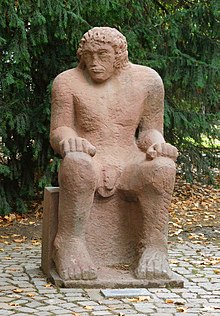Michael Siebel (sculptor)
Michael Siebel (born July 11, 1951 in Frankfurt am Main ) is a German sculptor .
life and work
Siebel grew up in Frankfurt-Sachsenhausen and studied, after an apprenticeship as a stonemason from 1974 to 1979, in the sculpture class of the Städelschule in Frankfurt with Michael Croissant (1928–2002) and Willi Schmidt (1924–2011).
Shortly after graduating in 1980, he received his first commission for a large- scale sculpture in public space with Die große Diagonale . The rhythmic surface of the large diagonal , a 2 × 1 meter granite block, was carved out by hand and at the installation site in three months in a vertical direction of movement. "To do this, the artist modeled the four side surfaces to give the stone a soft, as if indented shape, which is in contrast to the extreme natural hardness of the material ..." In 1983, the sculpture Seated followed , a monolithic, self-contained figure, which in its realistic manner remained a singular piece in Siebel's work. The historic red sandstone previously served as the base of the old Friedrich Stoltze monument in Frankfurt, which was moved and renewed in 1970.
In 1992 Siebel became the artistic director of the sculpture workshop of the "Jugendkulturwerkstatt Gallus", and in 2016 he retired. In this sculpture workshop in Gutleutviertel young offenders are - instead of a prison sentence - rehabilitated .
In 2000 his sculpture Living Stone was created on Gustavsburgplatz in Frankfurt's Gallusviertel , which is considered the first stone sculpture in public space whose conception includes being changed from time to time by the intervention of other artists. The 4 × 2 m, eight-ton, light sandstone block was sculpted by Siebel in 2000 together with residents of the district and members of the youth culture workshop. The French artist David Hurstel made a first change in 2003, and in 2015 the sculptor Simon Vogt worked on and changed the sculpture again together with the residents. Only the emblematic inscription “NOTHING STAYS AS IT IS”, which was chiseled into the stone from the start, remains unchanged.
In 2002, the city of Frankfurt commissioned the sculpture Fischernachen , which was built in a five-meter-long and 5-tonne red sandstone block to commemorate the fishing guild founded in 945. In 2005 Siebel received the Heusenstamm Foundation, Frankfurt award. In the same year he became a member of the Frankfurt Artists Society from 1857 .
Siebel lives and works in Frankfurt am Main and Wiesbaden .
Works in public space
- 1980: The large diagonal , granite sculpture. Taunusanlage location
- 1982: Coats of arms of the twin cities , bronze plaque, diameter 1.22 meters. Hasengasse location (Frankfurt am Main)
- 1983: Seated , sculpture in red sandstone. Location Eschenheimer Anlage
- 2000: Living Stone under construction from 2000. Sculpture in yellow sandstone, location: Gustavsburgplatz
- 2002: Fischernachen , sculpture in red Main sandstone. Obermainanlage location
Exhibitions
- 2009 Heussenstamm Gallery, Frankfurt am Main (with Inge Helsper-Christiansen)
Web links
Individual evidence
- ^ Website art in public space Frankfurt : The large diagonal
- ^ Website art in public space Frankfurt : Sitzender
- ^ Sybille Wilhelm: Working as a Sculptor as a Punishment ( Memento from March 4, 2016 in the Internet Archive ). In: Frankfurter Neue Presse from July 13, 2012
- ^ Andreas Fahrländer: Metamorphosis on Gustavsburgplatz . In: Frankfurter Allgemeine Zeitung , local section from June 1, 2015
- ^ Website art in public space Frankfurt : Fischernachen .
| personal data | |
|---|---|
| SURNAME | Siebel, Michael |
| BRIEF DESCRIPTION | German sculptor |
| DATE OF BIRTH | July 11, 1951 |
| PLACE OF BIRTH | Frankfurt am Main |


